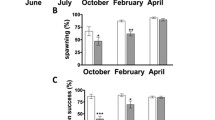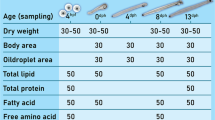Abstract
Although estrogens have been detected in some echinoderm species, their role is not clearly understood; so we examined the effects of estrogens administered to sea urchin embryos and larvae. A typical malformation was exogastrulation, induced by the exposure to ethynylestradiol (EER) in a defined period of 12 h from 12 h after fertilization (HAF). Morphogenesis for gastrulation was delayed in the treated embryos: protrusion of the archenteron started at 30 HAF when gastrulation had already finished in normal embryos. Exogastrulation induced by EER was cancelled by the antiestrogen chemical, ICI182,780. Feeding larvae were less sensitive to estrogens than those in early embryogenesis and, at certain concentrations, developed without abnormal morphology. The effect of estrogens was examined at the level of gene expression of the major yolk protein (MYP). MYP expression started during the larval stage and was suppressed by estrone at the six-armed stage, but not by β-estradiol, and in later stage larvae, the expression was not affected by treatment with either estrogen. Estrogens affect sea urchins in the early stage of embryogenesis, leading to abnormal morphogenesis and interference with gene expression.




Similar content being viewed by others
Abbreviations
- DAF:
-
days after fertilization
- EER:
-
ethynylestradiol
- HAF:
-
hours after fertilization
- ICI:
-
ICI182,780
- MYP:
-
major yolk protein
- RT-PCR:
-
reverse transcription polymerase chain reaction
- TAM:
-
tamoxifen
References
Cervello M, Matranga V. Evidence of a precursor–product relationship between vitellogenin and toposome, a glycoprotein complex mediating cell adhesion. Cell Differ Dev 1989;26:67–76.
Dan K, Okazaki K. Cyto-embryological studies of sea urchins. III. Role of the secondary mesenchyme cells in the formation of the primitive gut in sea urchin larvae. Biol Bull 1956;110:29–42.
Harrington FL, Ozaki H. The effect of estrogen on protein synthesis in echinoid coelomocytes. Comp Biochem Physiol 1986;84B:417–21.
Hayley M, Perera A, Robinson JJ. Biochemical analysis of a Ca2+-dependent membrane–membrane interaction mediated by the sea urchin yolk granule protein, toposome. Dev Growth Differ 2006;48:401–9.
Hiramatsu N, Matsubara T, Fujita T, Sullivan CV, Hara A. Multiple piscine vitellogenins: biomarkers of fish exposure to estrogenic endocrine disruptors in aquatic environments. Mar Biol 2006;149:35–47.
Hirate Y, Tomita K, Yamamoto S, Kobari K, Uemura I, Yamasu K, Suyemitsu T. Association of the sea urchin EGF-related peptide, EGIP-D, with fasciclin I-related ECM proteins from the sea urchin Anthocidaris crassispina. Dev Growth Differ 1999;41:483–94.
Ishihara K, Tonegawa Y, Suyemitsu T, Kubo H. The blastocoelic fluid of sea urchin embryo induces exogastrulation. J Exp Zool 1982;220:227–33.
Kiyomoto M, Kikuchi A, Unuma T, Yokota Y. Effects of ethynylestradiol and bisphenol a on the development of sea urchin embryos and juveniles. Mar Biol 2006;149:57–63.
Kominami T, Takata H. Gastrulation in the sea urchin embryo: a model system for analyzing the morphogenesis of a monolayered epithelium. Dev Growth Differ 2004;46:309–26.
Komukai M, Iizuka Y, Yasumasu I. Synthesis of protein enriched in Li+-induced vegetalized embryos of sea urchin during early development. Dev Growth Differ 1989;31:371–8.
Livingston BT, Wilt FH. Lithium evokes expression of vegetal-specific molecules in the animal blastomeres of sea urchin embryos. Proc Natl Acad Sci U S A 1989;86:3669–73.
Logan CY, Miller JR, Ferkowiez MJ, McClay DR. Nuclear b-catenin is required to specify vegetal cell fates in the sea urchin embryo. Development 1999;126:345–57.
Mwatibo JM, Green JD. Estradiol disrupts sea urchin embryogenesis differently from methoxychlor. Bull Environ Contam Toxicol 1998;61:577–82.
Noll H, Matranga V, Cervello M, Humphreys T, Kuwasaki B, Adelson D. Characterization of toposomes from sea urchin blastula cells: a cell organelle mediating cell adhesion and expressing positional information. Proc Natl Acad Sci U S A 1985;82:8062–6.
Noll H, Alcedo J, Daube M, Frei E, Schiltz E, Humpries T, Matranga V, Hochstrasser M, Aebersold R, Lee H, Noll M. The toposome, essential for sea urchin cell adhesion and development, is a modified iron-less calcium-binding transferin. Dev Biol 2007;310:54–70.
Okazaki K. Exogastrulation induced by calcium deficiency in the sea urchin, Pseudocentrotus depressus. Embryologia 1956;3:23–36.
Oetken M, Bachmann J, Schulte-Oehlmann U, Oehlmann J. Evidence for endocrine disruption in invertebrates. Int Rev Cytol 2004;236:1–44.
Pillai MC, Vines CA, Wikramanayake AH, Cherr GN. Polycyclic aromatic hydrocarbons disrupt axial development in sea urchin embryos through a b-catenin dependent pathway. Toxicology 2003;186:93–108.
Roepke TA, Synder MJ, Cherr GN. Estradiol and endocrine disrupting compounds adversely affect development of sea urchin embryos at environmentally relevant concentrations. Aquat Toxicol 2005;71:155–73.
Schoenmakers HJN, Dieleman SJ. Progesterone and estrone levels in the ovaries, pyloric ceca, and perivisceral fluid during the annual reproductive cycle of the starfish, Asterias rubens. Gen Comp Endocrinol 1981;43:63–70.
Scott LB, Leahy PS, Decker GL, Lennarz WJ. Loss of yolk platelets and yolk glycoproteins during larval development of the sea urchin embryo. Dev Biol 1990;137:368–77.
Shyu AB, Raff RA, Blumenthal T. Expression of the vitellogenin gene in female and male sea urchin. Proc Natl Acad Sci U S A 1986;83:3865–9.
Shyu AB, Blumenthal T, Raff RA. A single gene encoding vitellogenin in the sea urchin Strongylocentrotus purpuratus: sequence at the 5′ end. Nucleic Acids Res 1987;15:10405–17.
Sugni M, Mozzi D, Barbaglio A, Bonasoro F, Candia Carnevali MD. Endocrine disrupting compounds and echinoderms: new ecotoxicological sentinels for the marine ecosystem. Ecotoxicology 2007;16:95–108.
Suyemitsu T, Asami-Yoshizumi T, Noguchi S, Tonegawa Y, Ishihara K. The exogastrula-inducing peptides in embryos of the sea urchin, Anthocidaris crassispina: isolation and determination of the primary structure. Cell Differ Dev 1989;26:53–66.
Takata H, Kominami T. Shrinkage and expansion of blastocoel affect the degree of invagination in sea urchin embryos. Zoological Science 2001;18:1097–105.
Unuma T, Yamamoto T, Akiyama T. Effects of oral administration of steroids on the growth of juvenile sea urchin Pseudocentrotus depressus. Suisanzoshoku 1996;44:79–83. (in Japanese with English abstract).
Unuma T, Suzuki T, Kurokawa T, Yamamoto T, Akiyama T. A protein identical to the yolk protein is stored in the testis in male sea urchin, Pseudocentrotus depressus. Biol Bull 1998;194:92–7.
Unuma T, Yamamoto T, Akiyama T. Effects of steroids on gonadal growth and gametogenesis in the juvenile red sea urchin Pseudocentrotus depressus. Biol Bull 1999;196:199–204.
Unuma T, Okamoto H, Konishi K, Ohta H, Mori K. Cloning of cDNA encoding vitellogenin and its expression in red sea urchin, Pseudocentrotus depressus. Zoological Science 2001;18:559–65.
Unuma T, Yamamoto T, Akiyama T, Shiraishi M, Ohta H. Quantitative changes in yolk protein and other components in the ovary and testis of the sea urchin Pseudocentrotus depressus. J Exp Biol 2003;206:365–72.
Unuma T, Ikeda K, Yamano K, Moriyama A, Ohta H. Zinc-binding property of the major yolk protein in the sea urchin: implications of its role as a zinc transporter for gametogenesis. FEBS J 2007;274:4985–98.
Wasson KM, Gower BA, Hines GA, Watts SA. Levels of progesterone, testosterone, and estradiol and the androstenedione metabolism in the gonads of Lytechinus variegatus (Echinodermata: Echinoidea). Comp Biochem Physiol 2000a;126C:153–65.
Wasson KM, Gower BA, Watts SA. Responses of ovaries and testes of Lytechinus variegatus (Echinodermata: Echinoidea) to dietary administration of estradiol, progesterone and testosterone. Mar Biol 2000b;137:245–55.
Wikramanayake AH, Klein WH. Multiple signaling events specify ectoderm and pattern the oral–aboral axis in the sea urchin embryo. Development 1997;124:13–20.
Wikramanayake AH, Huang L, Klein WH. Catenin is essential for patterning the maternally specified animal–vegetal axis in the sea urchin embryo. Proc Natl Acad Sci U S A 1998;95:9343–48.
Xu RA, Barker MF. Annual changes in the steroid levels in the ovaries and the pyloric caeca of Sclerasterias mollis (Echinodermata: Asteroidea) during the reproductive cycle. Comp Biochem Physiol 1990;95A:127–34.
Yamasu K, Watanabe H, Kohchi C, Soma G, Mizuno D, Akasaka K, Shimada H, Suyemitsu T, Ishihara K. Molecular cloning of a cDNA that encodes the precursor to several exogastrula-inducing peptides, epidermal-growth-factor-related polypeptides of the sea urchin Anthocidaris crassispina. Eur J Biochem 1995;228:515–23.
Yokota Y, Sappington TW. Vitellogen and vitellogenin in echinoderms. In: Raikhel AS, Sappington TW, editors. Progress in vitellogenesis, reproductive biology of invertebrates, vol. XII, pt A. Enfield: Science; 2002. p. 201–21.
Yokota Y, Unuma T, Moriyama A, Yamano K. Cleavage site of a major yolk protein (MYP) determined by cDNA isolation and amino acid sequencing in sea urchin, Hemicentrotus pulcherrimus. Comp Biochem Physiol 2003;135B:71–81.
Acknowledgements
We thank Mr. Mamoru Yamaguchi (Tateyama Marine Laboratory, Marine and Coastal Research Center, Ochanomizu University) and the staff of the International Coastal Research Center, Ocean Research Institute, The University of Tokyo for the animal collections. The study was partly supported through a grant of Long-range Research Initiative (LRI) of the Japan Chemical Industry Association (JCIA).
Author information
Authors and Affiliations
Corresponding author
Rights and permissions
About this article
Cite this article
Kiyomoto, M., Kikuchi, A., Morinaga, S. et al. Exogastrulation and interference with the expression of major yolk protein by estrogens administered to sea urchins. Cell Biol Toxicol 24, 611–620 (2008). https://doi.org/10.1007/s10565-008-9073-y
Received:
Accepted:
Published:
Issue Date:
DOI: https://doi.org/10.1007/s10565-008-9073-y




